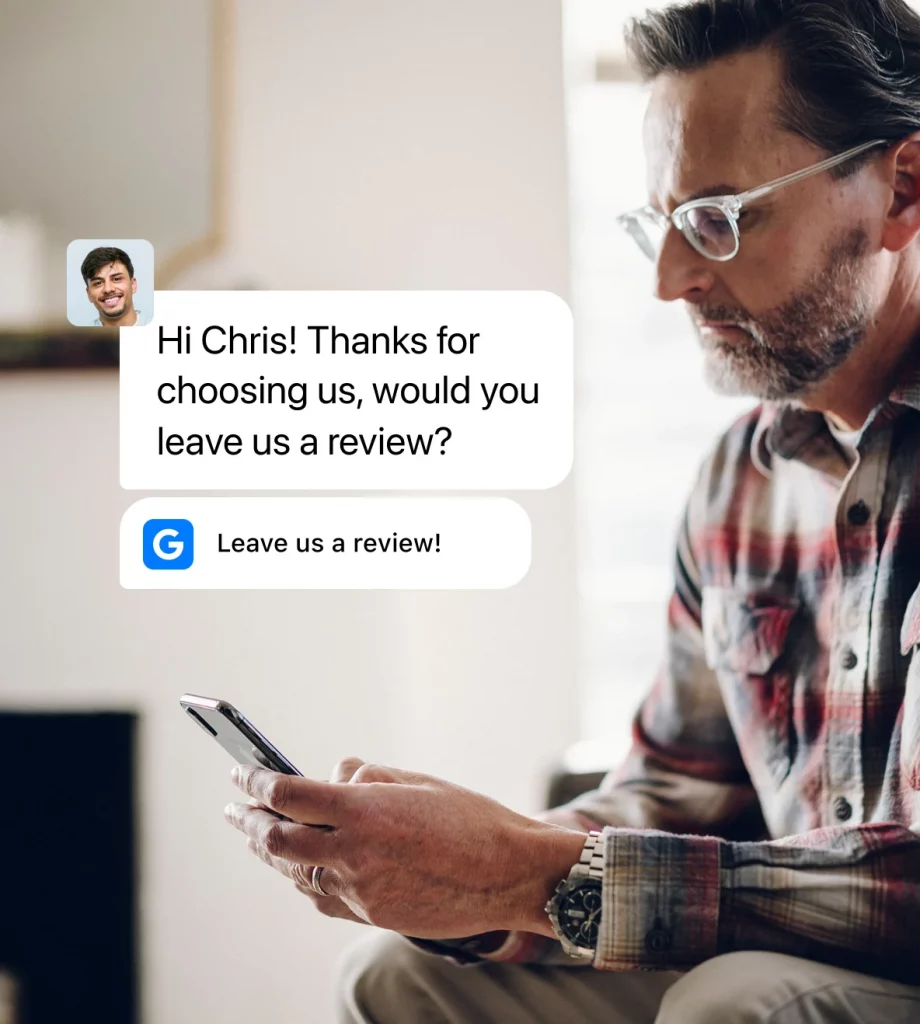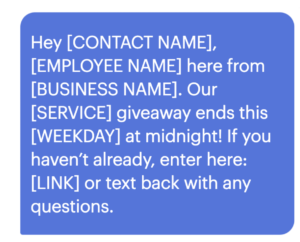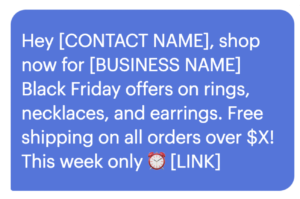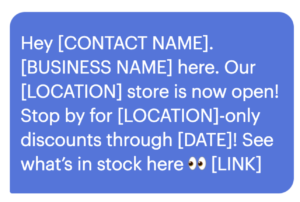Want to grow your business? You need to break through the noise of the competition. A marketing campaign helps your business by providing a strategic framework of marketing activities designed to achieve a specific business goal, like generating more leads or increasing brand awareness.
The specific goal of a marketing campaign will determine what strategies and marketing tactics will be most effective. Marketing campaigns can use a variety of media and channels to help achieve the overall goal. This includes email, text, television, radio, print, organic search, and paid digital advertising. Often the most effective marketing campaigns use multiple channels and tactics over several weeks or months.
This comprehensive guide to marketing campaigns will cover:
- What is a marketing campaign used for
- Understanding Marketing Campaigns
- How to Create a Marketing Campaign
- Distributing Your Marketing Campaign
- Converting Customers Through Your Marketing Campaign
- Assessing Your Marketing Campaign
- Useful Tools for Marketing Campaigns
- Examples of Successful Marketing Campaigns
What Is a Marketing Campaign Used For?
There are any number of reasons your business might decide to run a marketing campaign. Some of the most common reasons include:
- Increase brand awareness: Brand recognition is important. The more people have heard of your business, the more likely they are to trust it, buy from it, and refer others.
- Get more leads: There will always be customer attrition, so to keep your business thriving, you always need to work on finding potential new customers.
- Retain customers: It is much easier and more cost-effective to retain your customers. Thus, you must spend some of your marketing efforts on keeping these customers loyal to your brand.
- Improve brand image: The more people trust your brand and think highly of the quality of products or services it sells, the easier it will be to continue to convince people to not only buy from your business but advocate for others to also buy from your business. Thus, improving your brand image is a worthwhile marketing endeavor.
- Introducing a new product: When launching a new product, you need to generate awareness of the product and its benefits; a well-thought-out marketing campaign can help you do this.
- Increase sales of a specific product: Sometimes, a specific product lags in sales and you want to boost sales, or you may want to sell more of your most profitable product. A marketing campaign can bring awareness to a specific product and encourage more people to purchase it.
- Seasonal promotions: Holidays and seasonal events like Valentine’s Day or a Back-to-School sale are perfect opportunities to drive more traffic to your business and encourage customers to take advantage of time-based promotions.
- Grow more followers on your social media channels: By increasing your social media followers, you’re increasing brand awareness and reach. Thus, it’s worth investing the time, effort, and money in growing your subscriber base on your business’s social media channels.
- Increase your email or text subscriber list: Email and text are two of the best ways to communicate with customers, build loyalty, and retarget customers to purchase again. Growing your subscriber lists for these communication channels is always a smart business and marketing decision.
As you can see, there is almost an endless number of ways a marketing campaign can be used. The key criteria is simply that you have a purpose for your marketing campaign and devise a strategy that you believe will help your business achieve its goal.
Understanding Marketing Campaigns
Marketing campaigns are more than just a set of marketing activities. They have a strategic focus and purpose. The activities you undertake as part of a marketing campaign are intended to produce a specific desired result—such as to generate more revenue for the business, sell more of a specific product, book more appointments, or increase trust in your brand.
In the next two sections, we’ll help you understand marketing campaigns by discussing the types of marketing campaigns and the various campaign components that comprise any successful marketing campaign.
Types of Marketing Campaigns
When selecting the type of marketing campaign you want to run, the most important factor is making sure that it meets your business goals. Here are some of the more common marketing campaigns small and local businesses often use to achieve their business goals.
Customer Acquisition Campaigns
This type of campaign focuses on bringing new customers to your business that may not have heard about your business before. Because you are trying to reach customers with whom you don’t already have a relationship, you will want to consider using channels and media that can reach a broader audience than your current customers. Paid advertising, whether that’s digital pay-per-click, radio ads, TV ads, or direct mail marketing, are all tactics that can work well to help you find new customers. Positive online reviews can also be an important part of customer acquisition campaigns, so you may want to focus your marketing campaign on how to generate more online reviews from current happy customers.
The success of a customer acquisition campaign can be measured by how many new customers purchase your products or services. However, most marketing teams also look at the average cost to acquire a new customer. Ideally, you want to be able to acquire as many customers as possible for as low as possible cost.

Conversion Campaigns
A conversion occurs any time you get someone to take a desired action. While the ultimate conversion is typically getting someone to buy a product or service you sell, many marketing campaigns focus on micro conversions that can help bring potential customers closer to making a purchase.
Any conversion campaign will need a strong call to action that drives people to take the desired action. Conducting A/B testing on your call-to-actions and other campaign messaging can help you to improve conversions as you see what works best.
The success of a conversion campaign will depend on your conversion rate. While the average landing page conversion rate is 2.35%, text-focused campaigns often see much higher conversion rates. For instance, text can be a great strategy to convert people to make a purchase or book an appointment.
Text messages have an open rate of up to 98%. On average, 95% of text messages are opened within 3 minutes.
Retention Campaigns
Retention campaigns are about keeping the customers you already have and increasing their loyalty to your brand. Loyalty programs are one way many businesses try to increase customer retention. Staying in touch with customers through email, text, and other communications can also be part of a customer retention campaign, especially when these communications offer promotions or other benefits that encourage customers to make another purchase.
Kegan Insurance, for example, uses text messages to help keep customers engaged year-round, which encourages them to remain loyal and renew their policy annually.

Trust Campaigns
Brand trust is becoming a critical component of what makes people buy. In a recent survey by Edleman, 88% of respondents said whether they trusted a brand was of critical importance—and was more important than convenience, a good reputation, or whether they loved the brand.
Social proof, such as online reviews, is one of the best ways to build trust in your brand.
According to one local consumer survey, 91% of consumers between the age of 18 to 34 trust online reviews as much as personal recommendations. But the number of reviews also matters. In the same survey, consumers said they require a business to have an average of 40 online reviews before they believe its average star rating.
A marketing campaign that focuses on increasing the number of positive online reviews of your business’s products and services is a great way to build trust.

Seasonal Campaigns
Seasonal campaigns focus on a specific time of year or holiday, such as Mother’s Day, Back-to-School, or Christmas. They can also be tied to a specific season, such as a spring sale. Because these campaigns are tied to a certain date or season, they tend to be shorter in duration and offer heavy promotions to encourage action during the season or event that’s being promoted.
Promotional texts that include exclusive seasonal offers, such as those promoting Black Friday hours or Small Business Saturday deals, are a great strategy for seasonal campaigns.

Referral Campaigns
A customer referral program, sometimes called a refer-a-friend program, encourages current customers to recommend a product or service to their friends and family. In most cases, a business will offer a referral incentive that gives existing customers a good reason to actively reach out to potential new customers.
A successful referral program uses its best customers to do the talking for the business, which can be far more effective than spreading the message yourself. People trust their peers more than any other groups or ads, with as much as 92% of shoppers trusting the recommendations given to them by friends and family members.
To increase the likelihood of getting a customer referral, many business owners will also offer an incentive (such as a gift card, store credit, or swag) with the ask.
Hey Jodi, Thanks for your recent visit or Vista Dental. If you were happy with your experience, we’d love for you to refer us to a friend or family member. As a thank you, we’ll give you free teeth whitening session. Just share this [Link].
There are many more types of marketing campaigns that aren’t covered in-depth here, some of the more popular ones include:
- Brand awareness campaign
- Rebranding campaign
- Search engine marketing (SEM) campaign
- Social media marketing campaign
- Email marketing campaign
- SMS marketing campaign
- SEO campaign
- Partner marketing campaign
- Influencer marketing campaign
Marketing Campaign Components
Most businesses run multiple marketing campaigns every year. Every campaign will be different because each campaign’s goals will be unique, but there are some standard components that comprise every marketing campaign.
Campaign Purpose
All campaigns should have a well-defined goal they are trying to achieve. Do you want to garner more positive reviews online? Increase awareness about a new product you’re selling? Or simply book more appointments?
Whatever the goal is for your campaign, it should be concrete and measurable. For instance, you may set your campaign goal as increasing appointment bookings by 5% over the next three months.
Target Audience
They say you can’t always please everyone; the same is true in marketing your business. A marketing campaign should have a clearly defined audience that you are trying to reach. This way, you can ensure your message is tailored to resonate with a specific audience instead of being too broad or general to resonate with anyone.
For example, if you run a heating and cooling business and the purpose of your marketing campaign is to sell more air conditioner units, you may decide that your target audience for the campaign is people that currently do not have air conditioning (AC) or who have AC units that are more than 10 years old. Alternatively, if your marketing campaign goal was to book more HVAC service appointments, your audience might be those who have newer AC units that want to keep them well-maintained.
Set a Budget
Marketing campaigns can only be as ambitious as the budget you have to spend. Determining your budget at the onset will help you figure out what marketing activities on what channels you can afford.
If you have a small budget, free outreach tools like texting and your website may be a bigger priority since paid ads will quickly add up.
Determine the Duration of Your Campaign
A marketing campaign can be any length you determine is best to help you reach your goal. However, keep in mind that it takes time to build momentum around a marketing effort, and potential customers will likely need to hear the same messages and offers multiple times before taking action.
Finding the balance between not fatiguing customers with the same message but also making sure the message sinks in is the tricky part. Most marketing campaigns run around six months, but your campaign goals will help dictate the right length of time. Shorter campaigns may be appropriate if they are based on a specific event, such as Mother’s Day or Valentine’s Day, flash sales, or other time-sensitive promotions.
The marketing tactics you choose to use may also dictate how long your campaign should run. Paid search works well for short campaigns, but inbound tactics such as content marketing and organic search can often take 12 months or longer to optimize.
Determine What Channels You’ll Use
Most campaigns tend to be multi-channel, meaning that you’ll run your marketing message on more than one channel. This can help you reach a broader audience. Make sure that your message and brand voice are consistent across channels and assets you create for the campaign.
A multi-channel campaign can include both offline and online channels, such as:
- Phone
- Text
- Radio/TV
- Billboards
- Pay-Per-Click (PPC) ads
- Organic search (Google, Bing, etc.)
- Website
- Social media channels
- Google Business Profile
If you’re using channels like text or email, ensure you follow all privacy laws and other regulations.
Create a Call to Action
Your campaign should have some action you want your audience to take. This action should align with the goals of your campaign. If you’re trying to build greater awareness around a product or service, you may want people to sign up for a webinar where they can learn more. If you’re trying to book more appointments, you may want people to call your business or book an appointment online.

Measure Success
Make sure you have a way to track how all your marketing channels and tactics perform as well as how well you did at achieving your overall goal. This will help you in future campaign planning as you’ll better understand what marketing strategies are most effective with your target audience.
How to Create a Marketing Campaign (Step-by-Step)
The success of your marketing campaign depends on how well you manage your campaign. You need to have a clear process in place, remain organized throughout, and make adjustments to your campaign based on the results you’re seeing from your efforts.
Here is a step-by-step look at how to plan an effective marketing campaign:
Step 1. Define Your Campaign’s Objective
At a high level, your marketing campaign needs a goal, like increasing foot traffic at your store locations. However, it’s better to be even more specific when defining what you hope to accomplish with your marketing campaign.
Setting a SMART goal (specific, measurable, attainable, relevant, and timely) can help ensure you have a clear idea of what you’re trying to achieve. Using the SMART framework, for example, a diamond retailer may define their marketing campaign goal as:
- Specific: Sell more diamond earrings.
- Measurable: Sell at least 5 pairs of diamond earrings.
- Attainable: Reach out to over 5,000 customers directly via text.
- Relevant: Target audience are all customers who have purchased jewelry from the brand previously and will be drawn to coming to the store for a free ring cleaning.
- Timely: Offer is for this weekend only.
Having your goal clearly defined this way, makes it much easier to figure out how to message it and where. For instance, once the diamond retailer has set the above SMART goal for their campaign, they can compose a text that includes the specific details they outlined in their goal.

Step 2. Plan Your Campaign
Once you have a marketing strategy aligned to your business goals, you need to figure out what you actually need to do to carry out the strategy. To determine what channels and tactics will be most effective, the best place to start is by using your target audience parameters to understand what channels they’ll most likely be on and what types of marketing messages they will be receptive to.
To help ensure you’ve got a comprehensive plan, make sure you’ve detailed the following in your plan:
- What product or service you’ll be promoting
- Who you’ll be promoting it to
- What your main theme or concept will be for the campaign
- What marketing channels you’ll use
- What content or messages you’ll need for each channel
- When you’ll send out your campaign messages
Step 3. Create Your Message
You want to make sure that your message resonates with your target audience. Look at your specific goal and determine the messages most relevant to your audience. You’ll also need to ensure that your message aligns with your brand image.
Brainstorming creative ideas and concepts with your teams can help you come up with creative and engaging messages. Also, make sure you give yourself enough time to create your content and messaging before you plan to launch.
Step 4. Develop Your Media Strategy
Your media strategy will depend on who your target audience is. For instance, will posts on Facebook catch your audiences’ attention or are they more likely to respond to a text message? If you plan to use paid advertising, you’ll want to consider which channels your customers will most likely be on.
Similarly, the type of action you want your customers to take can influence your media strategy. If you’re trying to increase foot traffic at your store for the coming weekend, a radio promotion or text message may work better at getting people to your store than a post on social media.

Step 5. Implement Your Campaign
Now comes the exciting part, putting all your planning and creativity into action. To implement your campaign, you’ll want to make sure you’ve got all your assets scheduled on the appropriate channels at the appropriate time.
You’ll also want to ensure you have the resources lined up to respond to your campaign—whether that’s more store associates to help deal with an anticipated increase in foot traffic or employees to respond to texts, answer phone calls, etc.
Step 6. Measure and Analyze your Campaign
It’s important to take the time to look at how your campaign performed. Did you meet your goal? If so, why? If not, why not? What could you do differently next time to increase your success?
When determining how you’ll measure your campaign, consider setting up some checkpoints along the way.
If your campaign involves increasing brand trust and your goal is to reach 40 new online reviews within three months, set up some monthly benchmark notifications so you can gauge your progress and determine if you need to make any adjustments to meet your goals.
Distributing Your Marketing Campaign (Step-by-Step)
Once you’ve clarified your goals, audience, and message, it’s time to begin distributing your message. At this stage, you want to make sure that your message is delivered on the right channels, to the right people, and at the right time. To make this happen, a few things should be kept in mind.
Choose the Right Channels for Your Campaign
To determine the best distribution channels, start by determining which channels you already see the most engagement from your customers. This might be your website, a specific social media platform like Facebook or Instagram, or it might be text messaging.
Search engine results are commonly a leading source for consumers to discover small or local businesses, so you may want to make sure that your Google Business Profile is up-to-date and that you’re using keywords effectively on your website and in other content to help drive search traffic to your business.

Also, think about what your message is and what the best channel is for conveying that message. If, for example, you want to have people book an appointment, then use a medium that makes it easy for them to do this, such as by texting you back or using a click-to-call button or web chat on your website.
Finally, don’t forget to consider your budget. How much do you have to spend on paid channels versus how much will you need to use organic channels to reach your audience? You may also consider influencers. If there is an influencer that your customers respect and would take a referral from, it may be worth having them distribute content and information about your business.

Create a Distribution Schedule
Every campaign should have a specific duration of time it will run for. For something like a weekend flash sale, the timeline may be very short whereas, for a brand awareness campaign, the timeline may be months or even a year.
To ensure you have a distribution schedule that works for your campaign’s timeline, budget and goals, follow these steps:
- Create a campaign calendar that runs the duration of the campaign.
- Determine the cadence you want to distribute content—whether that’s several times a day, daily, weekly, etc.
- Assign different assets to each time slot you want to distribute content. Be sure to also note what channel each asset will be distributed on.
- Keep track of what it will cost you to run content like paid ads, and make sure you have the budget to meet the cadence you’ve set.
Test Your Distribution Plan
Automating distribution can take a lot of the stress out of campaign distribution. Look for tools that will let you schedule the distribution of your assets in advance, whether that’s SMS, email, or social media.

But before you set and forget your content for your campaign, be sure to test all your distribution tools to make sure there won’t be any glitches.
Converting Customers Through Your Marketing Campaign (Step-by-Step)
Every marketing campaign has a conversion goal. It may be making a purchase or something different, like getting a customer to subscribe to text messaging or leave a positive review about your business.
Whatever your conversion goal, there are a few steps you can take to help ensure you’re doing everything you can to get your audience to convert.
Drive Users Toward a Desired Action
First, make sure you’ve clearly defined for your campaign what this desired action is. Look back at the SMART goal you set.
Once you’ve defined that’s the action you want your customers to take, you need to think about how to best incentivize them to take it. In the case of a diamond jeweler, offering a free ring cleaning for stopping into the store is intended to help drive people to take the desired action.

Test and Optimize
The only way to improve conversions is to test and optimize. The primary areas you’ll want to test are your copy, your creative (i.e., visual design), and your call to action. Sometimes changing the color of a call to action button or even a word can make a big difference in whether people take the desired action and “convert.”
Make sure to only change one thing at a time, so you know whether a change made a difference or not. And always continue to test and optimize. Your customers’ behaviors and preferences are continually changing—so you’re copy, creative, and calls-to-actions will also need to be continually updated.
Monitor the Right Metrics
The metrics you monitor to determine how well your campaign is converting depend on what you’ve set as your conversion goal. For example, if your goal is to get customers to leave an online review of your product or service, the conversion metric you should track is the increase in reviews. Similarly, if you want more people to book an appointment, you need to track the number of appointments you’ve booked.
Be careful not to focus on metrics that don’t matter. Getting more traffic to your website may seem like a positive thing and it usually is, but if the people coming to your website aren’t a good fit and don’t take the next “conversion” step of contacting your business, it doesn’t really matter how many people visited your website.
Assessing Your Marketing Campaign
It is vital to measure your marketing performance so that you know that you’re spending your marketing dollars as efficiently and effectively as possible. Yet assessing your marketing campaign and correctly attributing leads to marketing activities and channels is one of the most complicated things marketers can do.
At the start of your campaign, when you’re setting your campaign goals, you also want to determine what metrics will be important for you to track to help you assess whether your campaign achieved the goal you set. These are called key performance indicators (KPIs).
The KPIs you track will depend on the different channels you use. Here are some of the KPIs you’ll want to track for different channels:
- Open rate
- Click-through rate
- Conversion rate
- Time to respond
- Number of unsubscribes
- Volume of traffic
- Time spent on page
- Session duration
- Click-through rates
- Conversion rates (such as downloading a guide or using click-to-call your business)
- Increase in followers
- Engagement (likes, shares, etc.)
- Impressions
- Click-through rate
- Reach
Determining Channel ROI
Once you’ve determined your KPIs you can use this information to help you make informed decisions about what channels and marketing tactics will provide the most bang for your buck. You’ll want to look at the amount you’re spending on a specific channel and compare that to what type of results you’re seeing.
For example, if you’re running paid ads on Facebook and one of your KPIs is how many click-throughs you are getting from the paid ad to your campaign landing page, you want to determine how much you spent on ads and how many click-throughs you received. This will help you determine your cost per click (CPC). You can then compare it with other channels, like Instagram, to see which one has a lower overall CPC and is therefore delivering the highest ROI.
Use Campaign Data to Improve Future Performance
Another important reason to measure campaign performance is to help boost performance on your next campaign. You can use those insights when planning your next campaign by assessing how previous campaigns and channels performed.
For example, if you see that more people clicked on your promotion when it was texted versus emailed, you’ll know for your next campaign that it probably makes sense to focus on texting as your primary channel for communicating.
Useful Tools for Marketing Campaigns
Just like there are endless marketing campaigns, tactics, and channels, there are also numerous tools you can use to help you plan and execute your marketing campaign.
Here are the top types of tools you’ll need to help you pull off a marketing campaign with the least effort and the greatest success:
Project Management
There are a lot of moving parts and resources involved in a marketing campaign. Having a project management tool can be invaluable to keep track of who needs to do what and when.
A project management tool can also provide a central location to store all your campaign assets and help facilitate reviews and approvals of those assets. Using an effective project management platform like Monday.com, ClickUp, or Trello can help organize your team’s efforts and keep on top of activities.
CRM
A customer relationship management (CRM) tool is also essential to any marketing campaign. A CRM keeps track of critical customer information, such as contact details like a customer’s email and phone number.
It can also store notes on interactions your business has with the customer, which can be really helpful for both marketing and sales teams when following up on leads.
SMS Marketing
Texting is becoming one of the best ways to reach customers in a marketing campaign. In fact, according to a Gallup poll, 68% of Americans under the age of 30 prefer texting over any other method of communication, and even more importantly, 90% of consumers want to use messaging when communicating with a business.
Consumers are twice as likely (1.8x) to prefer texting to any other communication method.
You want an SMS tool that will not only help you stay on the right side of privacy laws but make it easy to manage all of your text message conversations in one place.
Email Marketing
Email remains one of the primary ways businesses can communicate with customers. Email marketing tools make it easier to manage large email lists, including automating tasks like adding new subscribers and deleting unsubscribes.
The right email marketing tool can also help you automate email sequences for your campaigns and help you segment your list so you can target a specific audience for a specific campaign.
Online Reputation Management
For marketing campaigns focused on increasing brand awareness or generating more leads, you’ll likely want to focus on increasing positive reviews on your digital channels.
An online reputation management tool can help with this by helping you optimize the review request process and better manage and respond to online reviews.
Analytics
One of the most important parts of any marketing campaign is learning from it so you can do better next time. You will need analytic tools to help you track and measure your performance throughout the campaign, including being able to parse what channels, assets, and campaign messages performed well—and which ones didn’t.
Also, being able to tie specific ads, such as a billboard or radio ad, to a lead that calls your business with analytic tools like call tracking can help you better measure how your offline marketing tactics are working.
Examples of Successful Marketing Campaigns
If you’re looking for a few good examples of how other small, local businesses have launched successful marketing campaigns, here are a few to jump-start your creative juices.
1. S& R Insurance Marketing Campaign Increases Leads & Grows Website Traffic

S&R Insurance struggled with its local marketing. Scattered tactics made it hard to grow the business and difficult to know what was working. A weak online presence made it hard to find new customers, and there wasn’t a good way to communicate with prospects or customers on the website.
S&R created a marketing campaign to increase monthly leads by implementing Podium to increase website reviews and optimizing their Google Business Profile. Today, S&R says its grown 30% because of better reviews, and its website traffic has increased by 120% from its Google Business Profile.
→Read the full case study here.
2. Unstoppable Auto Group Rolls out a Texting Marketing Campaign

The Unstoppable Auto Group needed to improve the reputation of a few recently acquired dealerships. For this marketing campaign, the marketing team decided to pivot away from an email marketing strategy that wasn’t producing results. Instead, the Unstoppable Auto Group implemented Podium Campaigns, which allowed them to send incentives, promotions, and other messages to their customers by texting.
The team quickly built a robust text marketing subscriber list in a short time–over 11,400 customers subscribed in under 12 months. And the results were faster than the team expected.
“Texting is not like SEO where it takes several months. This is immediate. We send a text campaign out to a small fraction of our database in the last few days of the month, and we sell cars. It’s very powerful,” said Amir Alahwal, the Dealer Development Director.
In just one year, Unstoppable Auto Group has seen results like:
- Campaign click-through rates of 20-30%+
- 1 text campaign sold 5 cars in 1 week with a 35% click-through rate
- 50% increase in average reviews per month
→Read the full case study here.
3. Valley Roofing Marketing Campaign Increases Brand Awareness and its Online Reputation

Valley Roofing recognized how critical positive customer reviews were to their business reputation and increasing awareness, but they didn’t have a great way to capture testimonials, let alone get them online. Prior to 2019, the company had only been able to collect 22 reviews—which averaged out to just two per month.
To boost the number of reviews, Valley Roofing implemented Podium, which provided a more streamlined experience for collecting customer reviews by allowing customers to leave a review by texting them. The results were impressive. In just 24 months, Valley Review had 182 reviews with an average 4.9 star rating.
→Read the full case study here.
4. Jackson Hewitt Marketing Campaign Drives New Client Growth

As the country’s second-largest retail assisted tax prep brand, Jackson Hewitt prepares millions of federal, state, and local income tax returns every year. One thing Jackson Hewitt realized was that Google reviews were really driving clients to the company. However, they had no scalable system for Google reviews, which meant they were missing out on potential clients.
As part of a client acquisition marketing campaign, Jackson Hewitt implemented Podium, which allowed them to send out review invites via text message to streamline its online review program. With Podium, Jackson Hewitt saw a 64% increase in the quantity of reviews year-over-year, increased their overall average star rating from 4.73 to 4.77, and saved certain franchise owners a combined 150 hours each tax season in reporting. Most importantly, Jackson Hewitt saw those offices that had more reviews had more new client growth than stores with fewer/no reviews. Last year, the team scaled the new review program to 2,000 more Jackson Hewitt corporate stores.
→Read the full case study here.
5. RPM Alamo Focuses its Marketing Campaign on Lead Conversions

RPM Alamo, a residential property management company in San Antonio wanted to find a way to use its website to increase leads and conversions. Using Webchat, RPM Alamo salespeople were able to chat with website visitors in an easy and non-threatening way. The result? More viable leads for clients (property owners) and customers (renters).
“We’re increasing the speed of communication, and that converts leads,” Tony Yraguen, the owner of RPM Alamo said. As Webchat improved customer communication, customer satisfaction increased along with positive online reviews. “The overall increase for our business has been at least 20%,” Tony said. “We’ve generated more revenue, decreased vacancy rates, and pulled in more leads for our clients than we could have in multiple years. That is priceless.”
→Read the full case study here.
A Final Word on Marketing Campaigns
Marketing campaigns are a lot of work. They often take months to plan and execute. But they are a crucial component for any business that wants to grow their business and spread the word about new products or services – or the brand overall.
The best marketing campaigns are built on good planning as well as feedback loops as to what marketing messages, channels, and tactics work best with specific audiences. So, keep fine-tuning your marketing campaigns, and you’ll begin to not just reach your marketing goals—but exceed them.


